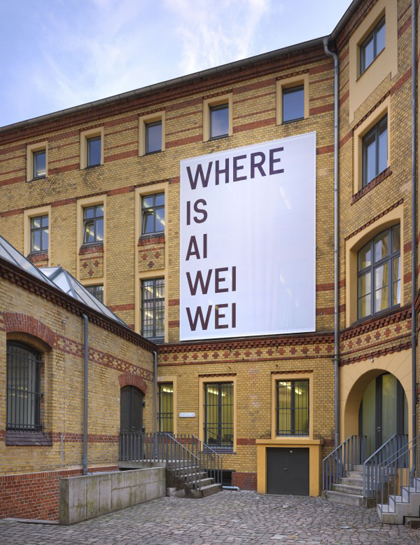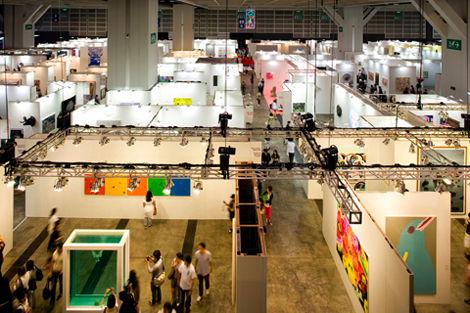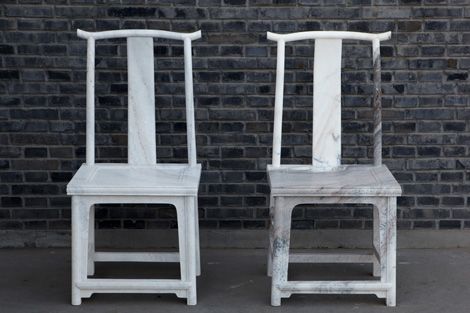Are individual freedom and free market part of the same equation?
This week M-Kos welcomes the opening of Art Hong Kong 2011 (AHK2011) and takes this opportunity to focus on a series of articles about contemporary art in East Asia, introducing museums, galleries and artists in Hong Kong, Beijing, Shanghai and Guangzhou.
Ai Weiwei “Fairytale” (2007) Courtesy of Galerie Urs Meile, Beijing-Lucerne, Erlenmeyer Stiftung Switzerland, Leister Foundation Switzerland
Art Hong Kong 2011 kicks off from Thursday 26 May until Sunday 29 May, amid protest over detention of Ai Weiwei by the Chinese authorities. The world, and especially the cultural sphere, prompted spontaneous petitions, sit-ins, rallys, as well as many exhibitions in his defense, held since his arrest on 3rd April. The Tate Modern has put up the words “Release Ai Weiwei” on top of its museum facade. Ai’s work “Circle of Animals/Zodiac Heads†were displayed both in New York City and Somerset House in London. In Berlin, Neugerriemschneider gallery is currently exhibiting his works entitled “Rock†(2011) and “Treeâ€(2011). The gallery front of Neugerriemschneider adorns a huge banner created by the artist Rirkrit Tiravanija, calling out “WHERE IS AI WEIWEI ?†Lisson Gallery, which represents him in London, also put up a huge ‘Free Ai Weiwei’ campaign banner for the opening of his exhibition on 11 May. In Paris, the artist Anish Kapoor dedicated his latest work “Leviathan” (2011) for Monumenta 2011 at the Grand Palais to Ai. In Hong Kong, which has its own separate legal system, dozens of supporters carried chairs to Victoria park to form the Chinese character “囚â€ï¼ˆPrison), a gesture inspired by Ai’s installation “Fairytale†(2007). Dozens of people gathered for “1,001 Chairs for Ai Weiwei” held both in New York and Toronto. The Museum of Contemporary Art San Diego organized a 24-hour sit-in inspired by Ai’s work “Marble Chair†(2010), two of which to be acquired by the museum. Countless more tales of worldwide support for him can be found.
A banner outside of Neugerriemschneider gallery in Berlin © Rirkrit Tiravanija
Under such circumstances, two opposing opinions are circulating over the upcoming AHK11 – boycott or not? According to AHK11 organizers, no signs of withdrawals from any participating gallery have been reported. In a recent Art Newspaper article, Jannie Haagemann, curator for Faurschou Gallery in Copenhagen and Beijing, comments that “All we can do in the art world is to continue showing his works.†The louder the protests grow, the wider the cause’s awareness will spread. Lisson Gallery also made this recent statement: “At this stage we feel we can do more for Ai Weiwei by being present at the fair. By continuing to show his work we build new audiences for it and draw attention to his plight. […] To withdraw from AHK11 and not show work by Ai would make us complicit with the authorities’ attempt to silence him and his supporters.” Most of the people in the art world share this sentiment and will keep raising an outcry against the Chinese government regardless of the authority’s prerogative over the ‘rule of law’. All demands made to the Chinese government regarding Ai Weiwei’s right to a transparent and fair legal process have so far been ignored. Followed by the news that Ai was allowed to have a family visit after 43 days in detention, Xinhua news agency (the official press agency of the Chinese government) reported that Ai’s company has evaded payment on huge amounts of tax. If the authorities accuse him on such bases, why is Ai not allowed assistance from his own lawyers? A sense of doubt and murkiness seems to hover over the whole affair. Until we get all the facts, the protest must go on.
Ai’s own words seem to best reflect his current situation:
“My work is always about dealing with real or fake, authenticity, what the value is, and how the value relates to current political and social understandings and misunderstandings.â€
So, will there be any protest action during Art Hong Kong 2011? Will the galleries gathering together in one place show their solidarity to support one single artist who’s basic human rights have been oppressed and neglected? Some will most likely take the fair as the perfect opportunity to do just that, within such befitting geographical and cultural contexts. On the other hand, lots may not dare intervene in another country’s political matters, and for them, things will just be business as usual. An artist’s freedom has been suppressed, but after all, isn’t it a free market ?
In actuality, Art Hong Kong is one of the hottest art fair in the world. Altogether there are 260 participating galleries from 38 different countries. On top of the main gallery area, the “Art Futures†section presents 48 emerging galleries worldwide, as well as “Asia Oneâ€, a new platform for art venues within the vast Asian terrain covering Turkey, the Middle East, the Indian subcontinent, the Far East, Australia and New Zealand, each presenting solo artist projects. AHK11 completes this comprehensive program by providing educational workshops, activities for children and guided tours, making the fair accessible to local communities. Art Hong Kong provides a platform for international art professionals to network, exchange ideas and instigate cultural debate. To sum up, the fair comes as a de facto gateway for dealers and collectors to access works and galleries in the Asia-Pacific region, an alternative entry point to the increasingly dominating Euro-US art market.
View from Art Hong Kong. Courtesy of Art Hong Kong
The past few years have seen the Chinese art market rise as the most rapidly emerging market, significantly influencing trends in the western hemisphere. According to ArtPrice reports of 2010, the Chinese art market has even superseded the number one position over USA for fine art revenues. For the galleries in the West, Hong Kong is a perfect place to strike on-the-spot business deals with eager Chinese collectors. About half of AHK11’s participating galleries are from Western countries, including a good number of major players. However, some experts speculate the Chinese art market’s bubble will burst sooner or later, and cause major impacts on the global art market. Unlike Euro-US economies, China does not have strong sustainable infrastructures. However, Art Hong Kong is reported to be amalgamating with MCH Group, the parent company of Art Basel, and this will help develop more stable infrastructures before any bubble burst arrives. That can’t be a bad deal.
Across China, Hong Kong remains a “special autonomous region†where British traditions of jurisprudence still place the city as an oasis of political stability and media freedom, as well as the engine for much of China’s explosive growth. Will this year’s Art Hong Kong Fair point out that individual freedom and free market are not part of the same equation?
Ai Weiwei “Marble Chair (2010) marble. Courtesy of the artist via the Museum of Contemporary Art San Diego
by Miwa Kojima




